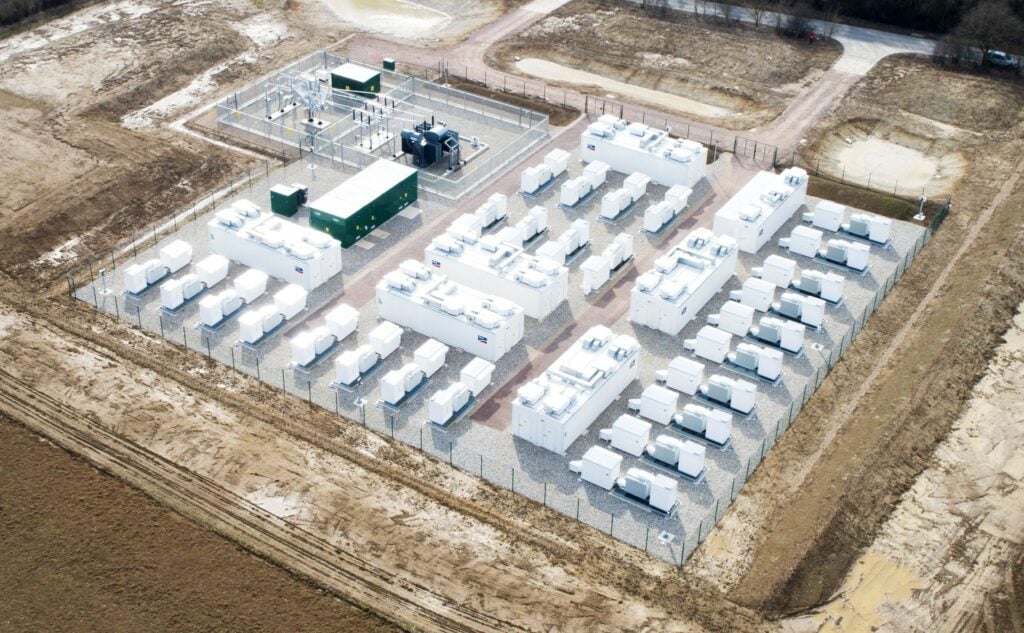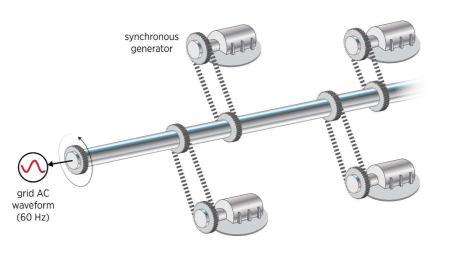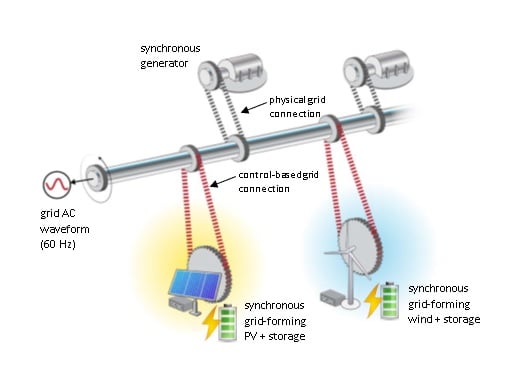
Reaching high levels of renewables is essential to global decarbonisation efforts. Enabling that means rethinking many of the 20th Century principles around which power grids the world over have been designed. Blair Reynolds, SMA America’s product manager for energy storage, discusses the role inverter-based renewable and storage technologies can play in maintaining grid stability.
There is no arguing that synchronous grid-forming technologies are necessary for renewables to supply the bulk of our baseload generation. The importance of this emerging technology will play a major part in the world’s rapidly accelerating clean energy transition.
Enjoy 12 months of exclusive analysis
- Regular insight and analysis of the industry’s biggest developments
- In-depth interviews with the industry’s leading figures
- Annual digital subscription to the PV Tech Power journal
- Discounts on Solar Media’s portfolio of events, in-person and virtual
A recent study by the Lawrence Berkley National Laboratory shows that only 24% of generation projects seeking interconnection from 2000 to 2015 in the United States were actually built.
That trend appears to be worsening.
With the majority of these projects being renewable or hybrid plants, the trend is troublesome, especially given national and regional climate goals.
Some of these projects were likely never going to pan out, but the overall takeaway remains; interconnection queues are becoming increasingly more congested, and approvals are becoming more difficult.
Breakdown of spinning reserve physics
Inside Climate News reports that PJM officials have recently proposed a two-year moratorium on new interconnection approvals.
This is in part the result of trying to reach high levels of renewable generation connected to a 20th century bulk power system. This is a system designed around the capabilities and behavior of synchronous rotating generators, whose common speed of rotation generates the grid AC waveform at a common frequency (i.e. 60 Hz).
Grid frequency can be simply described as a measure of the balance of electricity supply and demand across the network.

Nearly all inverter-based resources in service today are grid-following assets, and that means they rely on fast synchronisation with the external grid to tightly control their active and reactive current outputs. If these inverters cannot remain synchronised during grid events or under challenging network conditions, they are unable to maintain controlled, stable output.
Quite simply, we cannot reach 100% renewable generation without modifying the behaviour of a significant number of large-scale, inverter-based resources to mimic the behaviour of conventional synchronous rotating generators.
The deployment of inverter-based resources (i.e. wind, solar & storage) will continue to be a significant component of new generating resource additions in order for governments to reach their climate goals. As a result of the evermore inverter-based generation interconnecting to the bulk power system, the 20th century electric power grid will experience increased strain.
Key metrics
There are two key metrics which are commonly used by planners, manufacturers, and developers to obtain a high-level understanding of a localised power system’s strength and resiliency. Those are short circuit ratio (SCR) and inertia.
Short circuit ratio (SCR)
At a high level, SCR is used to describe the grid ‘strength’ at the point of generator interconnection – meaning how likely is it that the operation of the inverter-based resource itself will impact the stability of the grid.
The industry has seen such examples today, where utility-scale project developers wishing to interconnect inverters are denied approval, due to fears of destabilising an already ‘weak’ power grid. These ‘weak’ parts of the bulk power system are generally described as having low short circuit strength relative to the size of the (proposed) interconnected inverter-based resources.
This description of the electrical system strength refers to the sensitivity of the grid voltage at point of interconnection to fluctuations in a current injection coming from the inverter.
For comparison, in a ‘strong’ system, voltage and power factor are relatively insensitive to changes in current injection from the inverter-based resource, while this sensitivity is higher in a ‘weak’ system which could result in unstable operation of the inverter. These ‘weak’ areas could be a location with relatively sparse transmission and few synchronous generating resources nearby.
Furthermore, the existence of a high amount of grid-following inverter-based resources connected to the system can exacerbate the situation. SCR is routinely applied as a critical criterion in the decision-making process for interconnection studies of new renewable projects.
Inertia
Inertia, conversely, refers to the natural resistance of the system to changes in frequency which could drop if a large power plant or transmission fails.
It’s the inertia within the system which gives the power grid time to rebalance supply and demand by reducing the rate of change off frequency following an unexpected event. Inertia is an excellent indicator of the resiliency of the system to sudden changes.
These are the challenges we face with the wide scale adoption of grid-following inverter-based technologies.
What if inverters could literally inject strength and resiliency into the electric system thereby leaving the electric grid in better condition as a result? Wouldn’t that drastically help overcome the oppositions and concerns associated with interconnecting terawatts of new renewable generation on already strained electrical systems?
Using advanced power electronics and control mechanisms, inverter-based resources including wind and solar (when ideally paired with storage) can quickly detect frequency deviations and respond to system imbalances.
Tapping into electronic based resources for this ‘fast frequency response’ can enable response rates many times faster than traditional mechanical response from conventional generators, thereby reducing the need for inertia.
Synchronous grid-forming inverters can even provide inertia as needed by emulating the physical properties of rotating generators. The result is an injection of strength by increasing SCR. Synchronous grid-forming inverter-based generators can become a drop-in substitution for conventional generation assets in our bulk power system.

By emulating the physical properties of rotating synchronous generators through tight software control, grid-forming inverters can essentially replace rotating mass on the bulk power system.
Here is a simple analogy to explain the situation: Electrical generation today could be compared to tractor-trailer truck driving down the highway. Imagine the truck and its engine represent the large rotational generators that are used to generate the grid waveform. The trailer in this analogy is the aggregate of the inverter-based resources being dragged along for the ride.
Now imagine that the trailer is getting bigger and heavier while simultaneously the truck’s engine is beginning to lose horsepower and torque. Naturally, the towing speed would suffer as a result. The continuation of these trends simply would not be sustainable or productive. This is like the situation facing our electric grids, except that the electric grid can only slow a relatively small amount before it risks catastrophic collapse.
What can be done?
Imagine if the trailer could push itself and thus reduce the load on the truck towing it along. That’s essentially what synchronous grid-forming technology can do for the electrical grid.
Case study: Cape Cod Energy Storage Facility
Late in 2021, SMA commissioned a first-of-its-kind, 57.6 MW synchronous grid-forming energy storage facility which would not have been allowed to interconnect otherwise.
During the interconnection study review, the ISO recognized that the SCR at the point of interconnection was extremely low (<1.0). For context, a SCR below 3.0 is generally considered an indicator of a ‘weak’ grid, although SMA does guarantee stable operation with a SCR of at least 2.0 for our conventional grid-following inverters.
This grid situation was highly strained, in part due to the physical location of the project – at the very tip of the Cape Cod peninsula in Massachusetts, US. The location was far away from conventional synchronous generators and nearby an area that has seen a massive influx in new offshore wind capacity approved.
Under these conditions, a grid-following inverter-based system should experience classical voltage and control instability – leading to a near constant tripping of the inverters as they fight one another to inject current.
However, through careful modelling and close engagement with the plant stakeholders, SMA developed a grid-forming operational strategy that allowed the team to bolster the weak grid rather than drag it down further.
SMA and partners flipped the script on the very common obstacle which prevents high volume of renewable generators to interconnect to the bulk powder system by leaving the grid in better condition than it was found.
This avoided the need for expensive upgrades and investments in last century technologies.
The nature of what must be done to free up the interconnection of massive amounts of inverter-based resources as traditional forms of generation quickly become obsolete is complex. This is just the beginning of a new era, one the SMA America team is excited to watch progress.
Images taken from the NREL study: Denholm, Paul, Trieu Mai, Rick Wallace Kenyon, Ben Kroposki, and Mark O’Malley. 2020. Inertia and the Power Grid: A Guide Without the Spin. Golden, CO: National Renewable Energy Laboratory. NREL/TP-6120-73856.

